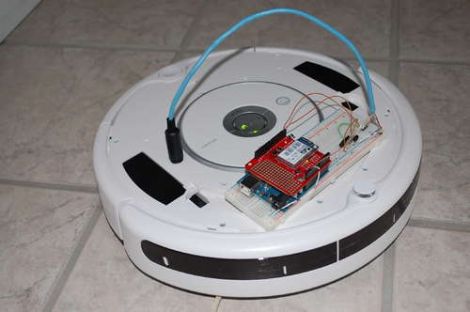
Instructables user [matchlighter] wanted to see what he could program his Roomba to do, so he decided he would make his little cleaning machine report its status on Twitter whenever something happened.
He popped open the Roomba’s case to access its serial connector, crafting a simple interface cable from some spare Cat5 he had sitting around. He added a small voltage regulator between the Roomba and his Arduino in order to protect it from the high power output present while the Roomba is charging. Once the proper bits were in place, he hooked the Roomba’s serial interface to the Arduino and attached a SparkFun WiFly shield to allow for wireless communications. After a bit of coding, the Roomba was sharing its activities with the entire world on Twitter.
Not only did he want the Roomba to tweet, but he decided that he also wanted the ability to control it from the web. He created a simple interface using a handy library he found online and was sending cleaning commands to the Roomba in short order.
While there is no video of the Roomba in action, you can check out what it is up to here, and there’s plenty of code to be had on his Instructables page.
















I wish there was a non Instructables version of theses instructions.
Too bad it look fugly, otherwise a nice hack.
to bad the wifly shield is hella expensive. Wouldn’t mind seeing this hack using bluetooth or zigbee for a little more cost effectiveness.
11:03 sucked up a hairball…. ewwwww
11:04 more dust
11:05 dirt
11:06 more dirt
11:07 even more dirt
11:08 dried up french fry…
11:09 food crumbles
11:10 dirt
11:11 ….. these people are disgusting…..
11:12 ERROR dirt spot not cleaning… ERROR
11:13 dirt
11:14 dust bunny
11:15 bottle cap
11:16 milk ring
11:17 more dirt
.,,,,
Oh yeah, I see the value in this.
And then we will have blogs with roombas complaining about how humans are dirty, and commenting on posts by GLaDOS.
All joking aside, why so much arduino projects never graduate from the breadboard? Some people even box up breadboard projects. I just dont get it, why use a 20eur breadboard when you can use a 4eur vero board?
The circuit translates nicely from the breadboard version.
@iHME Because then you have to buy the micro-controller, a programmer, figure out how to make the simple Arduino code translate into C and upload it to the chip. Here is when you realize you need a $30 programmer, oh and don’t forget making your own power supply, serial comm etc.
So now the $20 Arduino hack turns into a $50 project and much frustration.
@Fastjunk: sure, a power supply is expensive… How much costs a 7805 and two caps ?
The programmer will be used in every others project, so it’s a one time investment.
Serial comm… what ?
Why limiting to C when you can also use others languages, including the arduino stuff with all the available libraries ?
do roomba dream of electric dust bunnies?
@Fastjunk – Veroboard is a brand name for stripboard [http://en.wikipedia.org/wiki/Stripboard]; so I suspect he was more making a point about how this project – like many others – seems to be wasting/misusing a breadboard [designed for temporary prototype work] on the finished product.
I have to agree – breadboards are fantastic for prototyping, but they’re really not appropriate for leaving on a finished project. Especially one, like this, that’s going to be subject to a fair amount of movement and jostling; something breadboards really don’t handle all that well.
My Roomba has a nasty coke problem whenever we spill it off the coffee table…